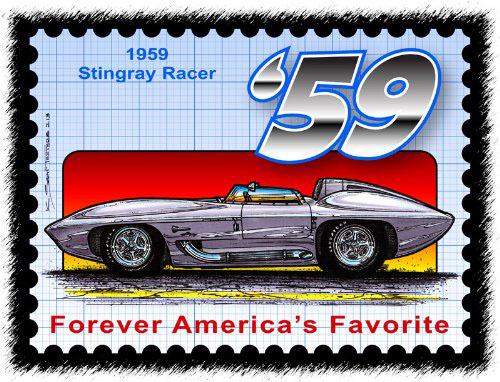Interview With Automotive Artist and Writer, K. Scott Teeters

Many of you know K. Scott Teeters as the renowned automotive artist who has written and illustrated for car magazines for over thirty years. He is most loved for his amazing Corvette art and writing for Vette magazine since 1997 and continuing until its last published edition for March 2020. He continues to write for Vette Vues and of course, Corvette Report. Here is an up front and personal interview with Scott featuring all the questions Corvette enthusiasts have wanted to ask him over the years.
Corvette Report (aka Karen Teeters) – I’ve known you for a long time and I know you’ve been drawing and writing about your love, Corvettes for years. When did your love affair with Corvettes start? Who was responsible for introducing you to the world of Corvettes? What was you initial response and why?
ST – My older brother, Bob, is 7 years older than me. So from my perspective, he’s always looked like an adult. In ‘65 when I was 11 years old, he bought a used, blue ‘57 Chevy, 2-door coupe. It was just a regular ‘57 Chevy, but a sweet car. One day he asked if I wanted to go for a ride to Haddonfield Chevrolet (in Haddonfield, NJ) to get the car serviced. Did I want to ride with my long side-burned big brother in his ‘57 Chevy? YOU BETCHA!
When we got there, he told me to wait for him in the showroom while he went into the Service Department. On the showroom floor was a new ‘65 Corvette Coupe. The salesman could see that I LIKED what I saw and gave me a sales brochure. I wish I could tell you I still had that brochure, but no, it’s long gone. But that did it for me! From there, it was model Corvettes and LOTS of car magazines. The models taught me what the parts were because I studied the instruction sheets that had call-outs on all the parts, and the magazines taught me all about cars and racing.
When I was a kid I was terribly dyslexic. “Reading” just didn’t make any sense to me and I was writing backwards and upside down. Plugging my nose into car magazines and reading them over and over, from cover to cover got me out of my reading challenge. Today I always have several books going at the same time and obviously I have no trouble writing. Actually, I enjoy writing almost as much as drawing. But seeing that first Corvette just blew me away.
A short while later in ‘67, there was a young guy that worked at Sattlers Trains & Hobbies, in Westmont, NJ named Bruce. I think he owns the place now. Bruce had a burgundy ‘67 427/435 Corvette roadster with SIDE-PIPES! We would hang around ’til closing just to see and hear Bruce leave work in his Vette. The sound of that throbbing solid-lifter big-block Corvette was what I thought sex would be like! That was a pretty good “response” I’d say. Worked for me for many years!
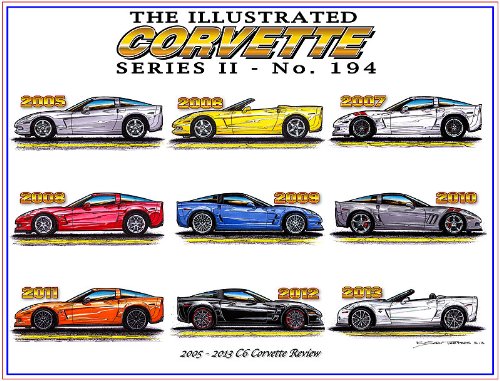
CR – When did you actually draw your first Corvette rendering and which Corvette was it?
ST – Although reading was a nightmare for me, drawing was a delight. Before the arrival of Corvettes into my life, I was drawing army tanks, jet planes, rockets, maps, and doing fancy lettering. While I don’t recall the first Corvette I ever drew, I was regularly drawing cars by the time I was into junior high school – 11 or 12 years old. When I saw my first Baldwin-Motion ‘68 Phase III SS-427 Corvette I thought I’d seen the perfect automobile – from a styling perspective. WOW!
CR – When and how did you did get your first professional, get a payment for your efforts, Corvette drawing?
ST – I was very good in high school mechanical drawing class – I got almost straight A’s. My teacher, Mr. Rudy Yeager, taught us multi-view orthographic drawing, the basics of casting, machining, materials, and technical illustration. He made a deal with all of his students. “You get an A in my class and if you want, I’ll get you a job when you graduate.” The artist/designer in me gravitated towards technical illustration. The week after I graduated from high school I got my first full time job as a draftsman AND as a part time track announcer at the Atco Raceway, in Atco, NJ.
The drafting thing didn’t work out – WAY too dry for me, so I got into construction – you know, macho, “let’s build stuff” kind of hard work. But I kept drawing cars for fun. In Fall of ‘74 the car magazines were all over Chevy’s new ‘75 Monza. I was still working at the Atco drag strip and was still into drag racing, big time. Being a Chevy guy, Bill “Grumpy” Jenkins was my drag racing hero. When I saw the new Monza, I created a “what if” drawing of what a Jenkins’ Monza might look like. My co-announcer at Cecil County Drag-O-Way (the Atco owners also owned Cecil County and I was assigned there), Tony Williams, liked the drawing and told me I should send it to Drag Racing USA. “Hey Man, they will DEFINITELY print that, Man. (Tony was kind of Tommy Chong-like and a real good guy) So I sent in a good photo copy and Neil Britt, the DRUSA editor called me and said that he wanted to run the art as a scoop, but could I do the drawing in pen & ink so it would print better? And, he was going to pay me $150!!! WOULD I???
By this time the construction business here in New Jersey was terrible, so I went back to drawing, but this time as a technical illustrator. I’d found my niche. I was good with Rapid-O-Graph pens, so doing the Jenkins’ Monza in ink wasn’t too much of a stretch. Having my art published in one of the drag magazines I’d been reading for years was a genuine thrill. Plus I got PAID!
I did another drawing for DRUSA of Dyno Don Nicholson’s then-new ‘69 Mach I Pro Stock Mustang. After that I did a drawing of one of John Greenwood’s wide-body IMSA Corvettes. So that was the first Corvette drawing I ever was paid for. I still might have that Greenwood IMSA Corvette drawing in my flat-files.
CR – When did you finally get your first Corvette? And tell the readers about that experience.
ST – A year after high school I moved out on my own. I was still working at Cecil County on the weekends and got to be friends with one of the tech guys, Omar Bolden. Omar had a Greenwood Green ‘67 427/435 Corvette Roadster. We used to talk Vettes every chance we had. One day he said to me, “Hey Scotty, I got a Corvette you might like to buy. A ‘67 roadster with L-88 flares, Hooker header side-pipes, and a big-block!” It turned out to be a VERY rough car that had been seriously abused. The 427 had blown up long before and was replaced with a 350-hp 396 (I think). The car had had a minor engine fire and the maroon paint on the front fenders was somewhat blistered, and other assorted dings, rips, and tears. But he only wanted $1,200! we called it “The Purple Wonder” because it was a wonder that it still ran!
It was LOUD and fast and needed TONS of work to get through inspection. The old guy at the inspection station was NOT going to let that car go through inspection on HIS WATCH with THOSE side-pipes! NO WAY! Then I learned that the parking brake system in the rear brakes was totally rusted out. And then one of the rear L-88 flares broke off. I also had a regular car, a ‘70 Chevelle. I was living in an apartment with no place to do much to the Corvette and facing LOTS of money for exhausts, brakes, body work, and lots of other smaller items, so I sold the car to a guy in Pennsylvania that bought and fixed up Corvettes. Jim Getz, was his name, I think. A year later, I couldn’t stand the Chevelle any more and was missing the Corvette. So I called Getz, the fellow I sold the ‘67 to and bought a silver ‘65 small-block Corvette Coupe with side-pipes and Cragar mags. SWEET!
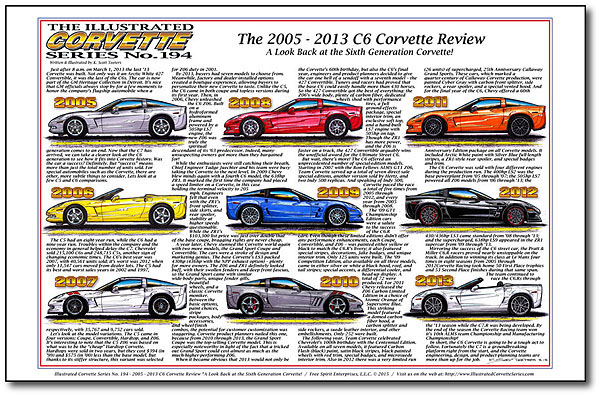
CR – Tell us about any interesting experiences with your Corvettes.
ST – One day on the way home from work in the ‘65 I blasted by a guy in a 356 Porsche Speedster. The side-pipes were original, over 10 years old, so those baffles were long gone making the car VERY loud. I guess I must have rattled his windows or he thought I was picking on his tubby car because he really took offense. We both pulled off Rt. 295 in New Jersey and headed west on the White Horse Pike. I really hadn’t paid him any attention until I heard him on my right yelling, “I ONLY GOT 4 CYLINDERS, MAN!!! FOUR CYLINDERS!!!” He was shaking his four fingers at me like a real nutter. When I realized he was pissed, I thought, “Don’t complain to me!” So I pushed in the clutch, red-lined the engine and let the side-pipes do the barking.
Eventually I rebuilt the engine, just a refresh with a few minor enhancements. I had Wither Automotive in Collingswood do the machine work. Paul Withers is a VERY good engine builder. After the engine was back together, Paul advised just running the car normally – don’t baby it, but don’t flog the pants off of it for 1,000 miles. About 3 weeks later, after 1,000 miles I changed the oil, put in new plugs, filters, reset the timing, etc…. and THEN flogged the pants off it it!
I wasn’t into knowing exactly what engine the car had or the rear gearing, trans details, but here’s what it could do: 50 mph out of first gear, 75 mph out of second, and 100 mph out of third gear. That particular blast was on 295 in New Jersey and I was coming up on traffic… FAST! The following Tuesday the car was stolen from work. The police found it Thursday and I had it back by Friday – minus my rebuilt engine, side-pipes, Hurst Shifter, 427 hood, door panels, drive shaft, and radio. It was not a good week. I was completely tapped out of money, so I sold the car back to Jim Gets and bought my friend’s ‘68 Camaro. Stuff happens.
CR – How long did you write and illustrate for Vette magazine? How did that relationship happen?
ST – I saw the very first issue of VETTE on the newsstand when it came out in Spring of ‘76. Marty Schorr was the editor / publisher and I was already familiar with his work as editor of CARS Magazine, my favorite car mag. I thought that VETTE was cool, but needed some art work. So I sent Marty a letter and samples. A week later he called me and asked, “So, what would you like to do?” I was “in” as his “pen yielding car freak” as he used to call me. That was ‘76 and I was active with vette til their last issue! The book had many editors and publishers and somehow managed to tag along.
CR – What articles are you most proud of?
ST – I’d have to say my regular feature, “The Illustrated Corvette Series” (Also called Designer Series) is what I am most pleased with. It’s been a great opportunity for me to not only enjoy drawing so many cool Corvettes, but I have a legitimate reason to buy and read LOTS of Corvette books and magazines. This isn’t the only “series” I’ve created in my car magazine / artist career. I’ve done two drag racing history series, another on Porsches, several muscle car and Fords series. But the Corvette series has been the most gratifying.
I often refer to the Corvette as a “modern American automotive miracle.” The miracle is that a car like the Corvette would be produced by a company like General Motors. That’s not a swipe at GM, but they are the quintessential American “corporation” with all of the stereotypical “corporate” aspects. The car had enemies right from the beginning that wanted nothing more than to kill it! But here’s where the story line turns into a mythical epic. Along comes this wild, white-haired Russian engineer that everyone had a hard time understanding, named Zora Arkus-Duntov just as the Corvette was being birthed in ‘53. Zora called it the most beautiful car he’s ever seen and proceeded to make the car into the legend it is today. No. Duntov didn’t do “everything,”on the Corvette, but it was his enthusiasm, passion for racing, and pure love for those that worked “with” him that turned on others to help make the car what it is today. And almost all the way throughout the Corvette story, there were those inside GM that wanted the Corvette to be DEAD! Well, to quote Oscar the grouch from Sesame Street, “Ding-dong, YOUR WRONG!”
CR – How do you get the ideas for some of the more unusual articles and illustrations about prototypes and racers?
ST – That’s a good question. The Illustrated Corvette Series was started in chronological order, so it was at first a matter of knowing the history and what was going on in Chevrolet from my reading that I could move through the years and cover the cars as they were produced and developed. As I went through the history of the car, here and there, there were a few prototypes, mule cars, specialty cars, and racers that I skimmed over, that I’m now going back and covering. I wasn’t aware of the Corvette “mule” cars that were used in the Corvette R&D Department. The media got to see some of those cars, such as Duntov’s white ‘69 ZL-1 that was setup like an SCCA A/Production racer. That was a COOL car!
I’ve also enjoyed doing look-backs to see where ideas came from that took decades to make their way into production Corvettes. The best example being the proposed ‘57 Q-Corvettes. Duntov and his team wanted the ‘60 Corvette to have a trans-axle, an aluminum engine with fuel-injection, full independent suspension, disc brakes and a one-of-a-kind body that eventually became the C2 Sting Ray. Of course, it took another 40 years before we saw the all-aluminum engine and trans-axle in the ‘97 C5 Corvette. But the thinking began in 1957. That’s a cool story! I just look for neat, unusual, little talked about aspects of the Corvette story and go from there.
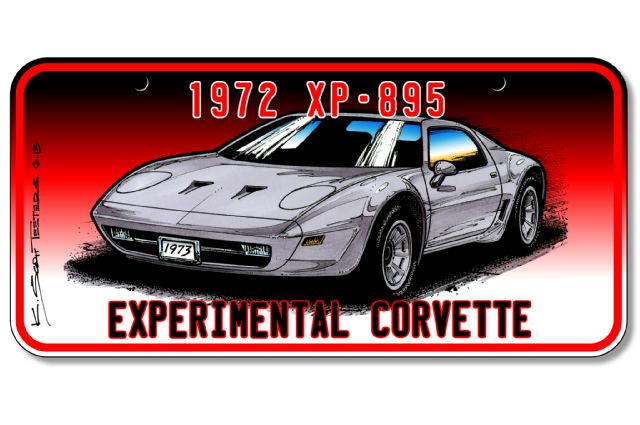
CR – Among all the interesting people in Corvette history, who is your favorite and why?
ST – I’d have to say, Zora Arkus-Duntov and Bill Mitchell. These guys had very strong personalities and often locked horns. There’s the famous blowout between the two men over the “split-window” on the ‘63 Corvette Coupe. That “split” was Mitchell’s pet design element and Duntov thought it was just plain stupid. Were it not for Zora’s inspiration and drive to make the Corvette a hard-ass sports car racer, the Corvette would have become a bloated, 4,000 pound boulevard cruiser, like the Thunderbird of the late ‘60s. But, if Zora had been in charge of styling, the Corvette would have looked like a front-engine Porsche. He didn’t particularly like the styling of the C2 or C3 Corvette.
And if Mitchell didn’t have Duntov behind the scenes making the Corvette a bad-ass racer, his beautiful Sting Ray and Mako Shark cars would have morphed and degenerated the way his Riviera did. So, the both needed each other, although at times, the fur would REALLY fly. Read Jerry Burton’s book “Zora Arkus-Duntov: The Legend Behind The Corvette,” it’s a great read.
CR – How can we find out about recent articles featured in Vette Vues?
ST – The easiest way is to check www.CorvetteReport.com as I usually publish the recent articles. I don’t post new prints and articles from the series until they come out in print. If you visit my Corvette Report, you can enjoy recent Vette Vues articles of mine and other Corvette related articles I have written about the latest and greatest in the Corvette world.
CR – Do you sell the drawings as “parchment prints only” or are they available in other forms?
ST – We have over 800 prints of Corvettes from ‘53 to now. Recently we decided to take the most popular years and make them available as canvas posters and canvas wraps. These are extremely popular as gifts as they make a very nice presentation and are available in several sizes as well. We have LOTS to work with and LOTS of possibilities. So many Corvettes… so little time.
CR – Have you ever wanted to race a Corvette? Which of the famous Corvette racing cars would you most like to drive if given the opportunity and why?
ST – Oh, sure, what Corvette enthusiast hasn’t? I am in my mid fifties now and I’m kind of over my lust for speed. If you don’t start doing that as a young person, as you get older, you’re more likely to not want to drive fast in cars. Being a child of the ‘60s, my current object of Corvette racing lust has to be Kevin Mackay’s restored ‘66 Penske L-88 Corvette Coupe. Not only is the car visually beautiful with the blue paint and yellow wheels and side-pipes, it has numerous unique detail elements, such as the prototype cowl induction big-block hood, the cover headlights, the rounded rear wheel wells and subtle rear fender bulges, racing mag wheels and header side-pipes. It’s, just for me, a drop-dead gorgeous Corvette. I’d love to build something along that line. I think only Kevin actually gets to drive the car. I love his work, by the way. He’s a really creative guy and I have a lot of respect for what he does. I’ve told him a few times he should offer rides in his functional ‘69 L-88 roadster that doesn’t have a body. Now THAT would be a fun ride!
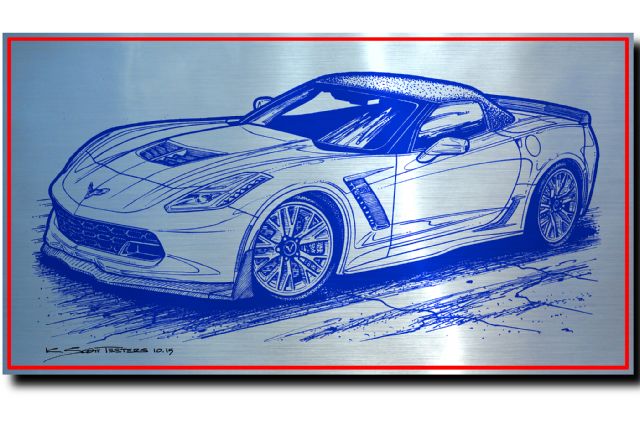
CR – What new projects are you working on?
ST – We’re working on adding my Etsy Shop called ManCaveCarArt to the CorvetteReport.com website. I am working on converting all the most popular Corvette years to the “print on demand” canvas posters and canvas wraps as these are available in larger sizes and look so great in man caves!
CR – Which is your favorite contemporary Corvette and why?
ST – I really like the looks of the new Grand Sport Corvettes. Even though they aren’t the fastest, baddest, they look fantastic and with all of the options and color combos, we’re sure to see some hot-looking Grand Sports. And for me, 436-horsepower is more than I need and more than enough to satisfy me. The ZR1 is an astonishing production car. I can’t believe that GM made that car, it’s that cool. But at $105,000 that’s twice the cost of a 430-horsepower Corvette. Is it worth the price? Compared to other high-end performance sports cars, definitely. For regular folks… The Z06 is a genuine stump-puller! I think it was the Z06 owners that gave Chevrolet the feedback telling them what an “out there” car the Z06 is and that they would do well to make high-performance driving school mandatory when buying this specialty Corvette. The ZR1 includes driver’s training. How cool is that? And I’ll wrap up this Corvette wish-list up with one last thing. Please, bring back the side-pipes. The Viper had them, so can the Corvette. Just don’t hide them, make’m tough-looking!
CR – Scott, thank you for your sharing.
ST – It’s always a pleasure talking Corvettes with you, Karen!
